Relationship of Forest Cover Fragmentation and Drought with the Occurrence of Forest Fires in the Department of Santa Cruz, Bolivia
Abstract
1. Introduction
2. Materials and Methods
2.1. Study Area
2.2. Sources of Information and Methods
2.2.1. Obtaining the Vegetation Cover
2.2.2. Forest Fragmentation
2.2.3. Distance from Anthropogenic and Forest Areas
2.2.4. Meteorological Drought
2.2.5. Identification of Burn Scars
2.2.6. Statistical Analysis
3. Results
3.1. Forest Fragmentation
3.2. Burn Scars
3.3. Evolution of Meteorological Droughts
3.4. Relationship between Forest Patch Characteristics and Fire Incidence
3.5. Influence of Distance to Forest Edges and Human Settlements
3.6. Relationship of Distance to Forest Edges and to Anthropogenic Zones and Impact of Drought Severity
4. Discussion
5. Conclusions
Author Contributions
Funding
Acknowledgments
Conflicts of Interest
Appendix A
| Size Classes Forest Patches (ha) | Variables | Distance to Forest | Distance Anthropogenic | SPEI-12 | % Forest Burn |
|---|---|---|---|---|---|
| <20 | Distance forest | 1.00 | |||
| Anthropogenic distance | 0.04 | 1.00 | |||
| SPEI-12 | −0.10 | −0.23 | 1.00 | ||
| % Forest burn | ns | ns | ns | 1.00 | |
| 20–200 | Distance forest | 1.00 | |||
| Anthropogenic distance | 0.08 | 1.00 | |||
| SPEI-12 | −0.10 | −0.23 | 1.00 | ||
| % Forest burn | ns | ns | ns | 1.00 | |
| 200–2000 | Distance forest | 1.00 | |||
| Anthropogenic distance | 0.19 | 1.00 | |||
| SPEI-12 | −0.08 | −0.12 | 1.00 | ||
| % Forest burn | 0.26 | 0.44 | −0.08 | 1.00 | |
| 2000–20,000 | Distance forest | 1.00 | |||
| Anthropogenic distance | 0.29 | 1.00 | |||
| SPEI-12 | ns | 0.29 | 1.00 | ||
| % Forest burn | 0.19 | 0.52 | 0.33 | 1.00 | |
| 20,000–200,000 | Distance forest | 1.00 | |||
| Anthropogenic distance | 0.42 | 1.00 | |||
| SPEI-12 | −0.43 | −0.61 | 1.00 | ||
| % Forest burn | 0.28 | 0.44 | −0.51 | 1.00 | |
| 200,000–2,000,000 | Distance forest | 1.00 | |||
| Anthropogenic distance | 0.45 | 1.00 | |||
| SPEI-12 | −0.24 | 0.55 | 1.00 | ||
| % Forest burn | 0.49 | 0.52 | −0.24 | 1.00 | |
| >2,000,000 | Distance forest | 1.00 | |||
| Anthropogenic distance | 0.11 | 1.00 | |||
| SPEI-12 | 0.23 | −0.18 | 1.00 | ||
| % Forest burn | 0.04 | −0.12 | 0.49 | 1.00 |
References
- Wilson, M.C.; Xiao-Yong, C.; Corlett, R.T.; Didham, R.K.; Ping, D.; Holt, R.D.; Holyoak, M.; Guang, H.; Hughes, A.C.; Lin, J.; et al. Habitat fragmentation and biodiversity conservation: Key findings and future challenges. Landsc. Ecol. 2016, 31, 219–227. [Google Scholar] [CrossRef]
- Gatti, L.; Gloor, M.; Miller, J.; Doughty, C.; Malhi, Y.; Domingues, L.; Basso, L.; Martinewski, A.; Correia, C.; Borges, V. Drought sensitivity of Amazonian carbon balance revealed by atmospheric measurements. Nature 2014, 506, 76–80. [Google Scholar] [CrossRef] [PubMed]
- Lizundia-Loiola, J.; Pettinari, M.L.; Chuvieco, E. Temporal Anomalies in Burned Area Trends: Satellite Estimations of the Amazonian 2019 Fire Crisis. Remote Sens. 2020, 12, 151. [Google Scholar] [CrossRef]
- De Faria, B.L.; Brando, P.M.; Macedo, M.N.; Panday, P.K.; Soares-Filho, B.S.; Coe, M.T. Current and future patterns of fire-induced forest degradation in Amazonia. Environ. Res. Lett. 2017, 12, 095005. [Google Scholar] [CrossRef]
- Aragão, L.E.O.C.; Anderson, L.O.; Fonseca, M.G.; Rosan, T.M.; Vedovato, L.B.; Wagner, F.H.; Silva, C.V.J.; Silva Junior, C.H.L.; Arai, E.; Aguiar, A.P.; et al. 21st Century drought-related fires counteract the decline of Amazon deforestation carbon emissions. Nat. Commun. 2018, 9, 536. [Google Scholar] [CrossRef]
- Cunha, A.P.M.A.; Zeri, M.; Deusdará Leal, K.; Costa, L.; Cuartas, L.A.; Marengo, J.A.; Tomasella, J.; Vieira, R.M.; Barbosa, A.A.; Cunningham, C.; et al. Extreme Drought Events over Brazil from 2011 to 2019. Atmosphere 2019, 10, 642. [Google Scholar] [CrossRef]
- Laurance, W.F.; Vasconcelos, H.L.; Lovejoy, T.E. Forest loss and fragmentation in the Amazon: Implications for wildlife conservation. Oryx 2000, 34, 39–45. [Google Scholar] [CrossRef]
- Cochrane, M.A. Synergistic interactions between habitat fragmentation and fire in evergreen tropical forests. Conserv. Biol. 2001, 15, 1515–1521. [Google Scholar] [CrossRef]
- Laurance, W.F.; Williamson, G.B. Positive Feedbacks among Forest Fragmentation, Drought, and Climate Change in the Amazon. Conserv. Biol. 2001, 15, 1529–1535. [Google Scholar] [CrossRef]
- Cochrane, M.A.; Laurance, W.F. Fire as a large-scale edge effect in Amazonian forests. J. Trop. Ecol. 2002, 18, 311–325. [Google Scholar] [CrossRef]
- Cochrane, M.A. Fire science for rainforests. Nature 2003, 421, 913–919. [Google Scholar] [CrossRef] [PubMed]
- Numata, I.; Silva, S.; Cochrane, M.A.; d’Oliveira, M.V.N. Fire and edge effects in a fragmented tropical forest landscape in the southwestern Amazon. For. Ecol. Manag. 2017, 401, 135–146. [Google Scholar] [CrossRef]
- Silva Junior, C.H.L.; Aragão, L.E.O.C.; Fonseca, M.G.; Almeida, C.T.; Vedovato, L.B.; Anderson, L.O. Deforestation-Induced Fragmentation Increases Forest Fire Occurrence in Central Brazilian Amazonia. Forests 2018, 9, 305. [Google Scholar] [CrossRef]
- Cano-Crespo, A.; Oliveira, P.J.C.; Boit, A.; Cardoso, M.; Thonicke, K. Forest edge burning in the Brazilian Amazon promoted by escaping fires from managed pastures. J. Geophys. Res. Biogeosci. 2015, 120, 2095–2107. [Google Scholar] [CrossRef]
- Killeen, T.J.; Guerra, A.; Calzada, R.; Correa, L.; Calderon, V.; Soria, L.; Quezada, B.; Steininger, M. Total historical land-use change in eastern Bolivia: Who, where, when, and how much? Ecol. Soc. 2008, 19, 36. [Google Scholar] [CrossRef]
- Hansen, M.C.; Potapov, P.V.; Moore, R.; Hancher, M.; Turubanova, S.A.; Tyukavina, A.; Thau, D.; Stehman, S.V.; Goetz, S.J.; Loveland, T.R.; et al. High-resolution global maps of 21st–century forest cover change. Science 342:850–853. Int. J. Adv. Eng. Technol. 2013, 7, 1161–1169. [Google Scholar]
- Müller, R.; Pacheco, P.; Montero, J.C. El Contexto de la Deforestación y Degradación de los Bosques en Bolivia: Causas, Actores e Instituciones; CIFOR: Bagor, Rajasthan, India, 2014; 89p. [Google Scholar]
- Steininger, M.K.; Tucker, C.J.; Ersts, P.; Killeen, T.J.; Villegas, Z.; Hecht, S.B. Clearance and Fragmentation of Tropical Deciduous Forest in the Tierras Bajas, Santa Cruz, Bolivia. Conserv. Biol. 2001, 15, 856–866. [Google Scholar] [CrossRef]
- Pinto, J.N.L.; Ruíz, T.C. Patrones de deforestación y fragmentación 1976-2006 en el municipio San Julián (Santa Cruz, Bolivia). Ecol. Boliv. 2010, 45, 101–115. [Google Scholar]
- Arancibia-Arce, L.R.; Perotto-Baldivieso, H.L.; Furlán, J.R.; Castillo-García, M.; Soria, L.; Rivero-Guzmán, K. Evaluación espacial y temporal de fragmentación y conectividad para actividades ecoturísticas en un sitio RAMSAR: Los Bañados de Isoso (Santa Cruz, Bolivia). Ecol. Boliv. 2013, 48, 87–103. [Google Scholar]
- Pinto-Ledezma, J.N.; Rivero, M.K. Temporal patterns of deforestation and fragmentation in lowland Bolivia: Implications for climate change. Clim. Chang. 2014, 127, 43–54. [Google Scholar] [CrossRef]
- Maillard, O.; Angulo, S.; Vides-Almonacid, R.; Rumiz, D.; Vogt, P.; Monroy-Vilchis, O.; Justiniano, H.; Azurduy, H.; Coronado, R.; Venegas, C.; et al. Integridad del paisaje y riesgos de degradación del hábitat del jaguar (Panthera onca) en áreas ganaderas de las tierras bajas de Santa Cruz, Bolivia. Ecol. Boliv. 2020, 55, 128–149. [Google Scholar]
- Romero-Muñoz, A.; Jansen, M.; Nuñez, A.M.; Toledo, M.; Almonacid, R.V.; Kuemmerle, T. Fires scorching Bolivia’s Chiquitano forest. Science 2019, 366, 1–1082. [Google Scholar] [CrossRef] [PubMed]
- Anívarro, R.; Azurduy, H.; Maillard, O.; Markos, A. Diagnóstico por Teledetección de Áreas Quemadas en la Chiquitania; Informe Técnico Del Observatorio Bosque Seco Chiquitano; Fundación para la Conservación del Bosque: Chiquitano, Santa Cruz, 2019; p. 70. [Google Scholar]
- Maillard, O.; Azurduy, H.; Bachfischer, M.; Castellnou, M.; Coronado, R.; Angulo, S.; Flores, R. Aportes a la Evaluación de Severidad de Quemas en la Chiquitania. Incendios 2019: Integrando tres Estudios de caso Alta Vista, Laguna Marfil y Ñembi Guasu; Fundación para la Conservación del Bosque: Chiquitano, Santa Cruz, 2020; p. 50. [Google Scholar]
- Sánchez-Azofeifa, G.A.; Portillo-Quintero, C. Extent and Drivers of Change of Neotropical Seasonally Dry Tropical Forests. In Seasonally Dry Tropical Forests; Dirzo, R., Young, H.S., Mooney, H.A., Ceballos, G., Eds.; Island Press: Washington, DC, USA, 2011. [Google Scholar]
- Fundación Amigos de la Naturaleza. Atlas Socioambiental de las Tierras Bajas y Yungas de Bolivia; Editorial FAN: Santa Cruz de la Sierra, Bolivia, 2015. [Google Scholar]
- Ferrer-Paris, J.R.; Zager, I.; Keith, D.A.; Oliveira-Miranda, M.A.; Rodriguez, J.P.; Josse, C.; González-Gil, M.; Miller, R.M.; Zambrana-Torrelio, C.; Barrow, E. An ecosystem risk assessment of temperate and tropical forests of the Americas with an outlook on future conservation strategies. Conserv. Lett. 2019, 12, e12623. [Google Scholar] [CrossRef]
- Gorelick, N.; Hancher, M.; Dixon, M.; Ilyushchenko, S.; Thau, D.; Moore, R. Google Earth Engine: Planetary-scale geospatial analysis for everyone. Remote Sens. Environ. 2017, 202, 18–27. [Google Scholar] [CrossRef]
- Guijarro, J.A. Daily series homogenization and gridding with Climatol v.3. In Climate Data and Monitoring WCDMP-No.85, Proceedings of the Ninth Seminar for Homogenization and Quality Control in Climatological Databases and Fourth Conf. on Spatial Interpolation Techniques in Climatology and Meteorology, Budapest, Hungary, 3–7 April 2017; WMO: Budapest, Hungary, 2017; pp. 175–180. [Google Scholar]
- Breiman, L. Random forests. Mach. Learn. 2001, 45, 5–32. [Google Scholar] [CrossRef]
- Olofsson, P.; Foody, G.; Herold, M.; Stehman, S.; Woodcock, C.; Wuldere, M. Good practices for estimating area and assessing accuracy of land change. Remote Sens. Environ. 2014, 148, 42–57. [Google Scholar] [CrossRef]
- Turner, M.G.; Gardner, R.H. Landscape Ecology in Theory and Practice. Pattern and Process, 2nd ed.; Springer: Verlag, NY, USA, 2015. [Google Scholar]
- Vogt, P.; Riitters, K. GuidosToolbox: Universal digital image object analysis. Eur. J. Remote Sens. 2017, 50, 352–361. [Google Scholar] [CrossRef]
- Vogt, P.; Riitters, K.H.; Caudullo, G.; Eckhardt, B. FAO–State of the World’s Forests; Forest Fragmentation: Luxembourg, 2019. [Google Scholar] [CrossRef]
- Vicente-Serrano, S.M.; Beguería, S.; López-Moreno, J.I. A multi-scalar drought index sensitive to global warming: The standardized precipitation evapotranspiration index. J. Clim. 2010, 23, 1696–1718. [Google Scholar] [CrossRef]
- Hargreaves, G.L.; Samani, Z.A. Reference crop evapotranspiration from temperature. Appl. Eng. Agric. 1985, 1, 96–99. [Google Scholar] [CrossRef]
- Ball, G.H.; Hall, D.J. ISODATA, a Novel Method of Data Analysis and Pattern Classification; Stanford Research Institute: Menlo Park, CA, USA, 1965. [Google Scholar]
- Key, C.H.; Benson, N.C. Landscape assessment: Ground measure of severity, the composite burn index; and remote sensing of severity, the normalized burn ratio. In Fire Effects Monitoring and Inventory System; Lutes, D.C., Keane, R.E., Caratti, J.F., Key, C.H., Benson, N.C., Sutherland, S., Gangi, L.J., Eds.; USDA Forest Service, Rocky Mountain Research Station: Ogden, UT, USA, 2006; pp. 219–273. [Google Scholar]
- Lilliefors, H. On the Kolmogorov-Smirnov test for normality with mean and variance unknown. J. Am. Stat. Assoc. 1967, 62, 399–402. [Google Scholar] [CrossRef]
- Gross, J.; Ligges, U. Nortest: Tests for Normality. Available online: https://CRAN.R-project.org/package=nortest (accessed on 23 May 2020).
- Rodríguez, A. Cartografía multitemporal de quemas e incendios forestales en Bolivia: Detección y validación post-incendio. Ecol. Boliv. 2012, 47, 53–71. [Google Scholar]
- Rodriguez-Montellano, A.M. Incendios y Quemas en Bolivia, Análisis Histórico Desde 2000 a 2013; Editorial FAN: Santa Cruz de la Sierra, Bolivia, 2014. [Google Scholar]
- Maillard, O.; Anívarro, R.; Vides-Almonacid, R.; Torres, W. Estado de conservación de los ecosistemas de las serranías chiquitanas: Un caso de estudio de la Lista Roja de Ecosistemas de la UICN en Bolivia. Ecol. Boliv. 2018, 53, 128–149. [Google Scholar]
- Asner, G.P.; Knapp, D.E.; Broadbent, E.N.; Oliveira, P.J.; Keller, M.; Silva, J.N. Selective logging in the brazilian amazon. Science 2005, 310, 480–482. [Google Scholar] [CrossRef] [PubMed]
- Broadbent, E.N.; Asner, G.P.; Keller, M.; Knapp, D.E.; Oliveira, P.J.; Silva, J.N. Forest fragmentation and edge effects from deforestation and selective logging in the brazilian amazon. Biol. Conserv. 2008, 141, 1745–1757. [Google Scholar] [CrossRef]
- Hansen, M.C.; Wang, L.; Song, X.P.; Tyukavina, A.; Turubanova, S.; Potapov, P.V.; Stehman, S.V. The fate of tropical forest fragments. Sci. Adv. 2020, 6, eaax8574. [Google Scholar] [CrossRef]
- McDaniel, J.; Kennard, D.; Fuentes, A. Smokey the tapir: Traditional fire knowledge and fire prevention campaigns in lowland Bolivia. Soc. Nat. Resour. 2005, 18, 921–931. [Google Scholar] [CrossRef]
- TIERRA. Fuego en Santa Cruz. Balance de los Incendios Forestales 2019 y su Relación con la Tenencia de la Tierra; Edición TIERRA: Santa Cruz, Bolivia, 2019. [Google Scholar]
- Pivello, V.R. Fire Management for Biological Conservation in the Brazilian Cerrado; Savana and Dry Forests. Linking People with Nature; Mistry, J., Berardi, A., Eds.; Ashgate: Farnham, UK, 2006; pp. 129–154. [Google Scholar]
- Wood, J.R.I.; Mamani, F.; Pozo, P.; Soto, D.; Villarroel, D. Libro Rojo de las Plantas de los Cerrados del Oriente Boliviano; Darwin Iniative & Museo de Historia Natural: Noel Kempff Mercado, Santa Cruz, 2010.
- Vides-Almonacid, R.; Reichle, S.; Padilla, F. Planificación Ecorregional del Bosque Seco Chiquitano; Editorial Fundación para la Conservación del Bosque: Chiquitano, Santa Cruz, 2007; p. 245. [Google Scholar]
- Catchpole, W. Fire Properties and Burn Patterns in Heterogeneous Landscapes. Flammable Australia: The Fire Regimes and Biodiversity of a Continent; Bradstock, R.A., Williams, J.E., GillCambridge, A.M., Eds.; University Press: Cambridge, UK, 2002; pp. 50–75. [Google Scholar]
- Bradstock, R.A. A biogeographic model of fire regimes in Australia: Current and future implications. Glob. Ecol. Biogeogr. 2010, 19, 145–158. [Google Scholar] [CrossRef]
- Alvarado, E.; Sandberg, D.V.; de Carvalho, J.A., Jr.; Gielow, R.; Santos, J.C. Landscape fragmentation and fire vulnerability in primary forest adjacent to recent land clearings in the Amazon arc of deforestation. Floresta 2004, 34, 169–174. [Google Scholar] [CrossRef][Green Version]
- Rossa, C.G.; Fernandes, P.M. Live fuel moisture content: The ‘pea under the mattress’ of fire spread rate modeling? Fire 2018, 1, 43. [Google Scholar] [CrossRef]
- Nepstad, D.; Verissimo, A.; Alencar, A.; Nobre, C.; Eirivelthon, L.; Lefebvre, P.; Schlesinger, P.; Potter, C.; Moutinho, P.; Mendoza, E.; et al. Large-scale impoverishment of Amazonian forests by logging and fire. Nature 1999, 398, 505–508. [Google Scholar] [CrossRef]
- D’Angelo, S.A.; Andrade, A.C.S.; Laurance, S.G.; Laurance, W.F.; Mesquita, R.C.G. Inferred causes of tree mortality in fragmented and intact Amazonian forests. J. Trop. Ecol. 2004, 20, 243–246. [Google Scholar] [CrossRef]
- Haddad, N.M.; Brudvig, L.A.; Clobert, J.; Davies, K.F.; Gonzalez, A.; Holt, R.D.; Lovejoy, T.E.; Sexton, J.O.; Austin, M.P.; Collins, C.D.; et al. Habitat fragmentation and its lasting impact on earth’s ecosystems. Sci. Adv. 2015, 1, e1500052. [Google Scholar] [CrossRef] [PubMed]
- Cochrane, M.A.; Laurance, W.F. Synergisms among Fire, Land Use, and Climate Change in the Amazon. Ambio 2008, 37, 522–527. [Google Scholar] [CrossRef] [PubMed]
- Bounoua, L.R.S.; DeFries, M.L.; Imhoff, M.; Steininger, K. Land use and local climate: A case study near Santa Cruz, Bolivia. Meteorol. Atmos. Phys. 2004, 86, 73–85. [Google Scholar] [CrossRef]
- González-M, R.; García, H.; Isaacs, P.; Cuadros, H.; López-Camacho, R.; Rodriguez, N.; Pérez, K.; Mijares, F.; Castano-Naranjo, A.; Jurado, R.; et al. Disentangling the environmental heterogeneity, floristic distinctiveness and current threats of tropical dry forests in Colombia. Environ. Res. Lett. 2018, 13, 45007. [Google Scholar]
- Veldman, J.; Putz, F.E. Grass-dominated vegetation, not species-diverse natural savanna, replaces degraded tropical forests on the southern edge of the Amazon Basin. Biol. Conserv. 2011, 144, 1419–1429. [Google Scholar] [CrossRef]
- D’Antonio, C.; Vitousek, P. Biological invasions by exotic grasses, the grass/fire cycle, and global change. Annu. Rev. Ecol. Syst. 1992, 23, 63–87. [Google Scholar] [CrossRef]
- Nepstad, D.C.; Lefebvre, P.; Lopes da Silva, U.J.; Tomasella, P.; Schlesinger, L.; Solórzano, P.; Moutinho, D.; Ray, J.; Guerreira, B. Amazon drought and its implications for forest flammability and tree growth: A basin-wide analysis. Glob. Chang. Biol. 2004, 10, 704–717. [Google Scholar] [CrossRef]
- Silvério, D.V.; Brando, P.M.; Balch, J.K.; Putz, F.E.; Nepstad, D.C.; Oliveira-Santos, C.; Bustamante, M.M.C. Testing the Amazon savannization hypothesis: Fire effects on invasion of a neotropical forest by native cerrado and exotic pasture grasses. Philos. Trans. R. Soc. B 2013, 368, 20120427. [Google Scholar] [CrossRef]
- Gascon, C.; Williamson, G.B.; da Fonseca, G.A. Receding forest edges and vanishing reserves. Science 2000, 288, 1356–1358. [Google Scholar] [CrossRef]
- Lazarte, M.C. Efecto de Borde en la Composición, Estructura y Diversidad Florística en Fragmentos de Bosque (Cortinas Rompe-Vientos) Semideciduo Chiquitano, “Propiedad Agrícola San Rafael”, Cuatro Cañadas, Santa Cruz–Bolivia. Bachelor’s Thesis, Universidad Autónoma Gabriel René Moreno, Santa Cruz de la Sierra, Bolivia, 2009. [Google Scholar]
- Castellnou, M.L.; Alfaro, M.; Miralles, D.; Montoya, B.; Ruiz, T.; Artes, L.; Besold, J.; Brull, F.; Ramirez, M.A.; Botella, F.; et al. Field journal: Bolivia learning to fight a new kind of fire. Analyzing and acting on extreme wildfires in Chaco (Bolivia) and Cerrado (Paraguay) ecosystems. Wildfire Mag. 2019, 28, 26–34. [Google Scholar]
- Brando, P.M.; Paolucci, L.; Ummenhofer, C.C.; Ordway, E.M.; Hartmann, H.; Cattau, M.E.; Rattis, L.; Medjibe, V.; Coe, M.T.; Balch, J. Droughts, Wildfires, and Forest Carbon Cycling: A Pantropical Synthesis. Annu. Rev. Earth Planet. Sci. 2019, 47, 555–581. [Google Scholar] [CrossRef]
- Chen, Y.; Morton, D.C.; Andela, N.; van der Werf, G.R.; Giglio, L.; Randerson, J.T. A pan-tropical cascade of fire driven by El Niño/Southern Oscillation. Nat. Clim. Chang. 2017, 7, 906–911. [Google Scholar] [CrossRef]
- Marengo, J.; Tomasella, J.; Alves, L.; Soares, W.; Rodríguez, D. The drought of 2010 in the context of historical droughts in the Amazon region. Geophys. Res. Lett. 2011, 38, 1–13. [Google Scholar] [CrossRef]
- Blunden, J.; Arndt, D. State of the Climate in 2016. Bull. Am. Meteorol. Soc. 2017, 98, S1–S282. [Google Scholar] [CrossRef]
- Erfanian, A.; Wang, G.; Fomenko, L. Unprecedented drought over tropical South America in 2016: Significantly under-predicted by tropical SST. Sci. Rep. 2017, 7, 1–11. [Google Scholar] [CrossRef]
- Maillard, O.; Salinas, J.C.; Angulo, S.; Vides-Almonacid, R. Riesgos ambientales en las unidades hidrográficas de las serranías chiquitanas, departamento de Santa Cruz, Bolivia. Ecol. Boliv. 2019, 54, 84–97. [Google Scholar]
- Devisscher, T.; Anderson, L.O.; Aragão, L.E.O.C.; Galván, L.; Malhi, L. Increased wildfire risk driven by climate and development interactions in Bolivian Chiquitania, southern Amazonia. PLoS ONE 2016, 11, e0161323. [Google Scholar] [CrossRef]
- Calle, Z.; Murgueitio, E.; Chará, J. Integrating forestry, sustainable cattle-ranching and landscape restoration. Unasylva 2012, 239, 31–40. [Google Scholar]
- Alencar, A.A.; Brando, P.M.; Asner, G.P.; Putz, F.E. Landscape fragmentation, severe drought, and the new Amazon forest fire regime. Ecol. Appl. 2015, 25, 1493–1505. [Google Scholar] [CrossRef]
- Brando, P.M.; Soares-Filho, B.; Rodrigues, L.; Assunção, A.; Morton, D.; Tuchschneider, D.; Fernandes, E.C.M.; Macedo, M.N.; Oliveira, U.; Coe, M.T. The gathering firestorm in southern Amazonia. Sci. Adv. 2020, 6, eaay1632. [Google Scholar] [CrossRef] [PubMed]
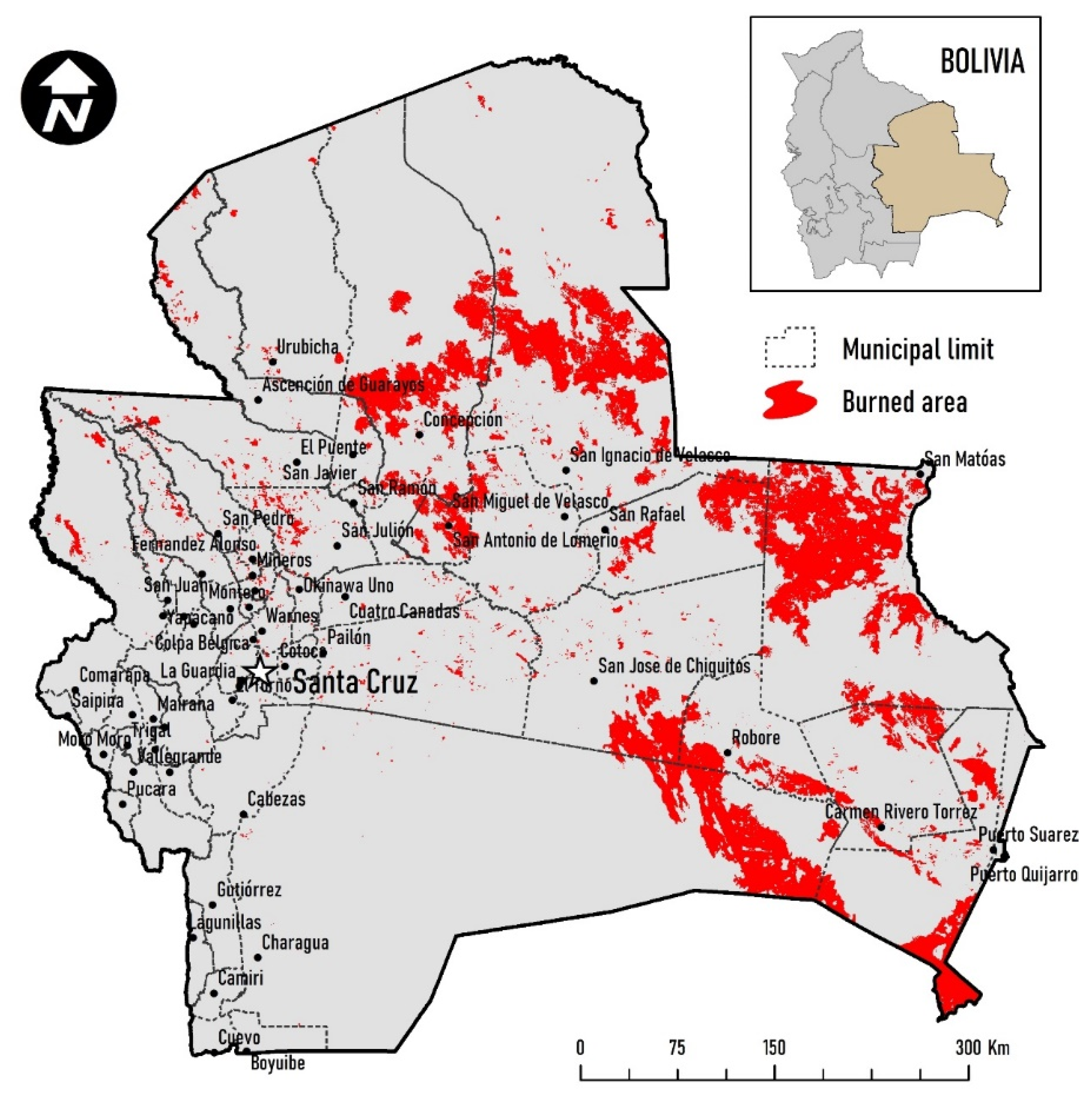
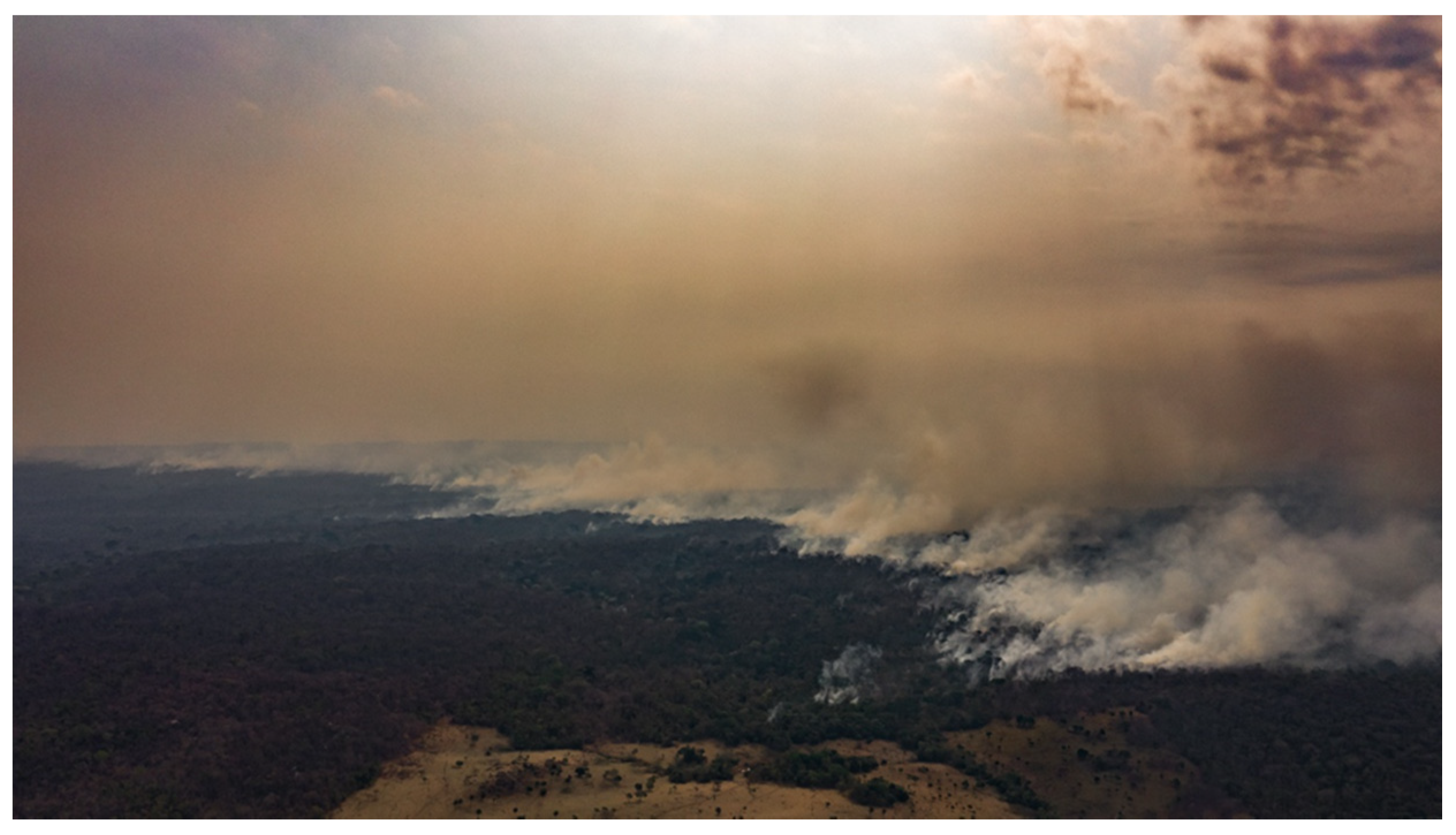
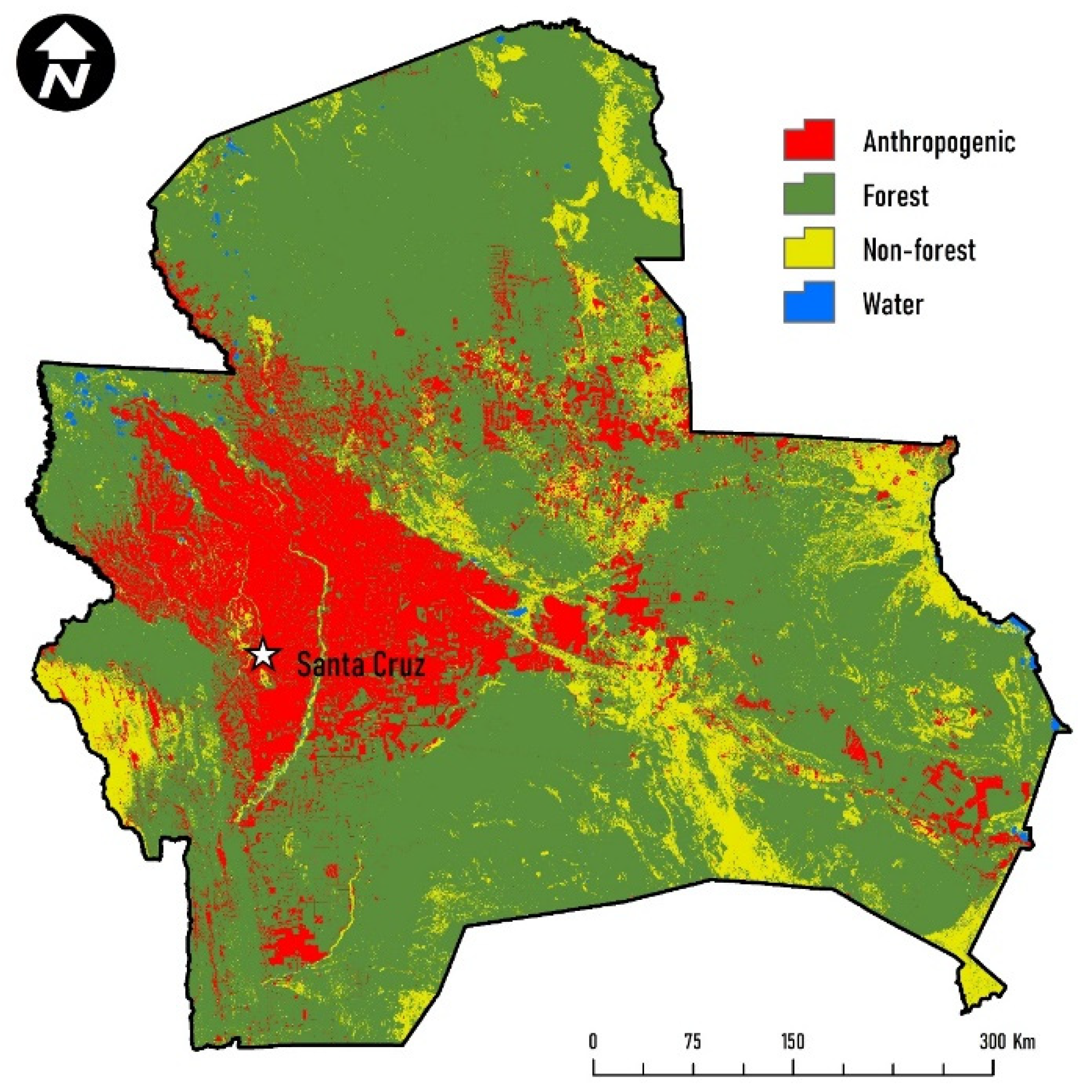
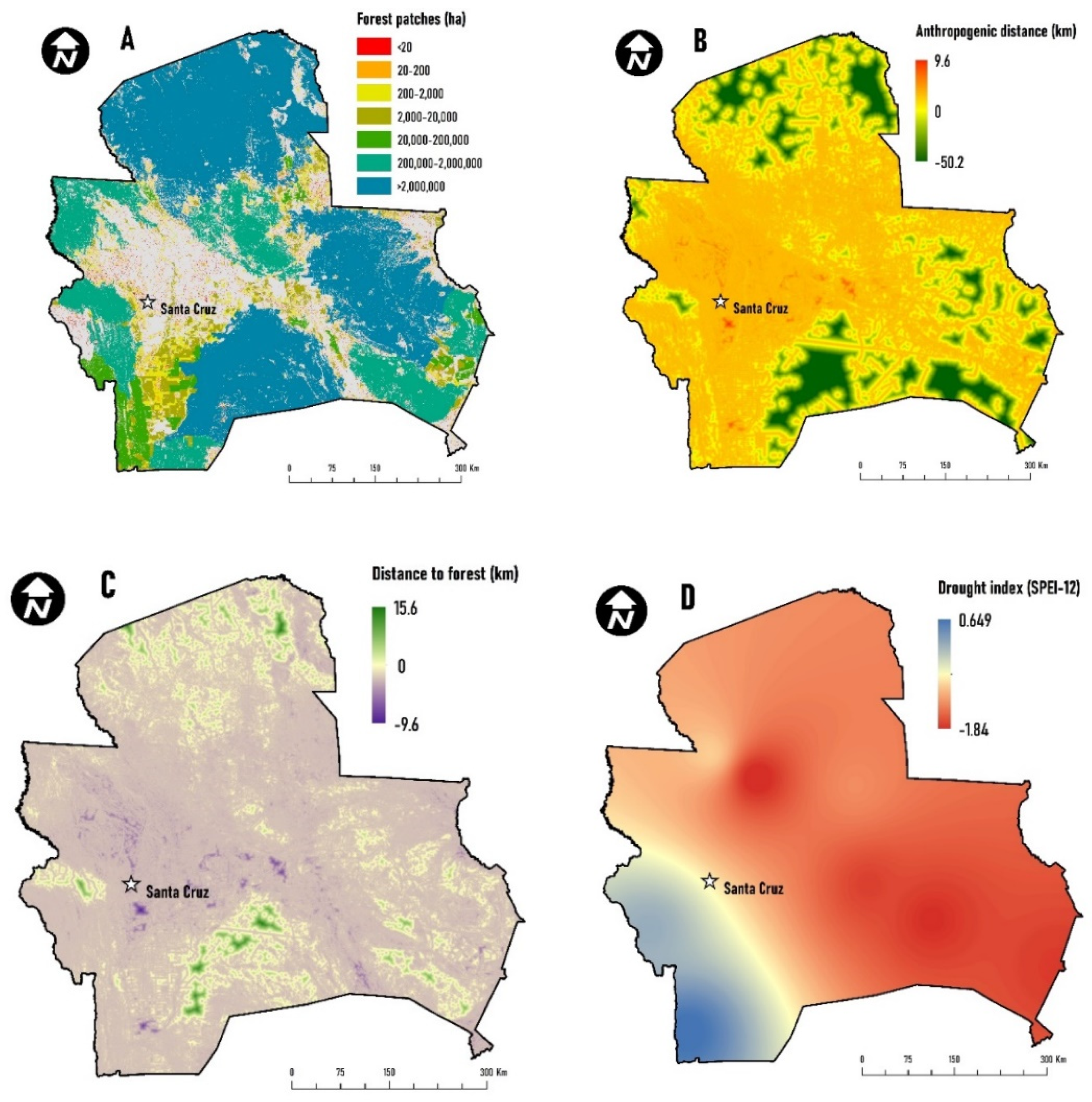


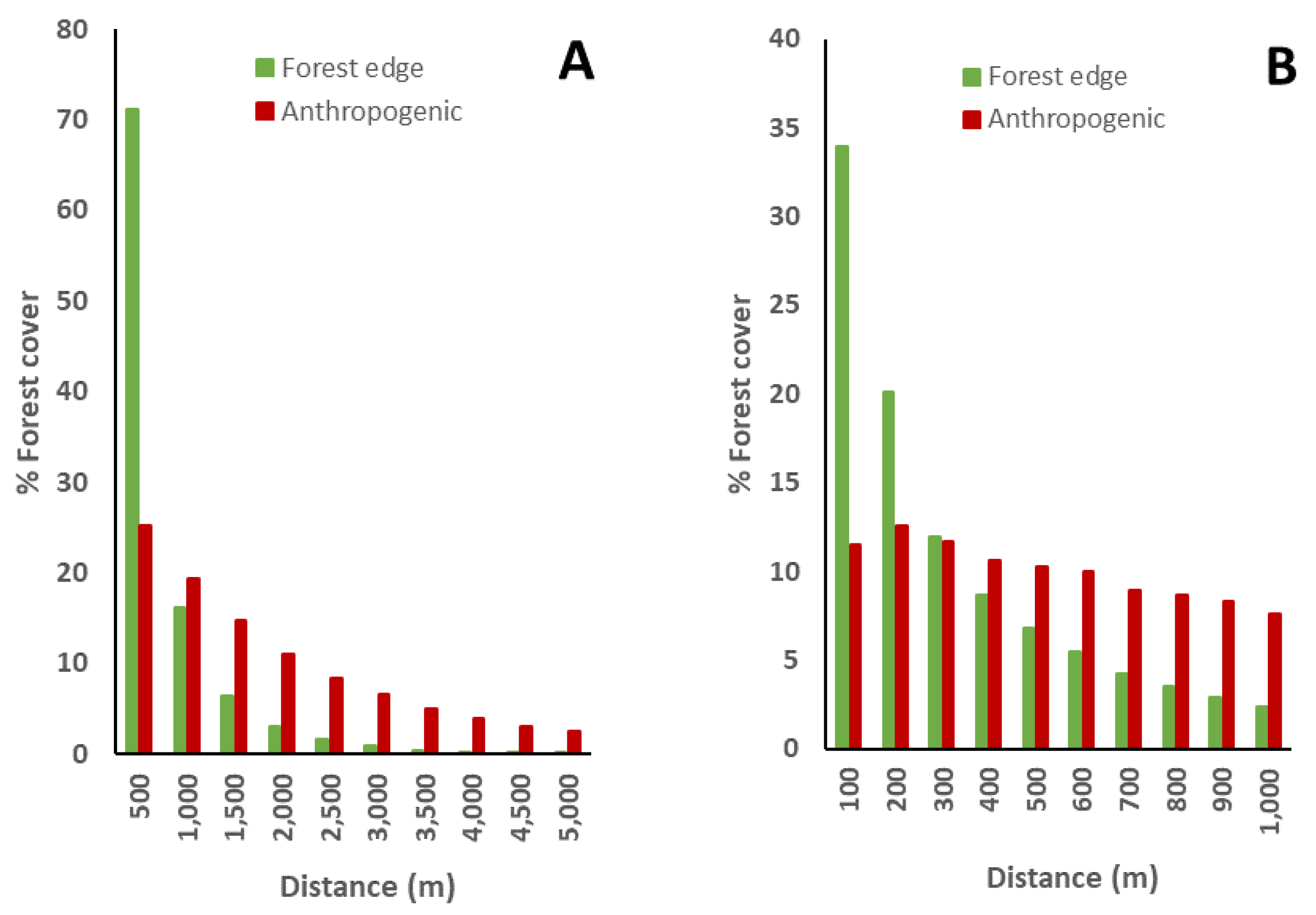
| Class | Anthropogenic | Forest | Non-Forest | Water | Total (Wi a) |
|---|---|---|---|---|---|
| Anthropogenic | 16.2404 | 0.3483 | 1.1320 | 0 | 0.1685 |
| Forest | 2.1506 | 60.7536 | 21.7745 | 0 | 0.7070 |
| Non-forest | 0.2567 | 1.2405 | 7.4001 | 0.0428 | 0.1198 |
| Water | 0 | 0 | 0 | 0.4662 | 0.0047 |
| Total | 18.6477 | 62.3424 | 30.3066 | 0.5090 | 1 |
| User’s accuracy | 96% | 86% | 62% | 99% | |
| Producer’s accuracy | 87% | 97% | 24% | 92% | |
| Overall accuracy | 85% |
| Size Scales of Forest Patch (ha) | Area (ha) | Area (%) |
|---|---|---|
| <20 | 481,286 | 1.8 |
| 20–200 | 514,487 | 2.0 |
| 200–2000 | 1,092,855 | 4.2 |
| 2000–20,000 | 1,639,171 | 6.2 |
| 20,000–200,000 | 1,425,452 | 5.4 |
| 200,000–2,000,000 | 5,919,073 | 22.5 |
| >2,000,000 | 15,233,947 | 57.9 |
| Station (Name) | Z | Q |
|---|---|---|
| Ascención de Guarayos | −3.20 * | −0.04 * |
| Camiri | −1.22 | −0.02 |
| Puerto Suárez | −3.16 * | −0.04 * |
| Roboré | −1.43 | −0.02 |
| San Ignacio de Velasco | −2.46 * | −0.03 * |
| San Javier | −1.69 | −0.02 |
| San José de Chiquitos | −2.09 * | −0.03 * |
| Vallegrande | −1.32 | −0.02 |
| Forest Patch Size Classes (ha) | Number of Degraded Patch | Burnt Area (ha) | Burnt Area (%) | % Forest Size Class Burned |
|---|---|---|---|---|
| <20 | 118,058 | 82,266 | 3.8 | 17.1 |
| 20–200 | 1485 | 51,812 | 2.4 | 10.1 |
| 200–2000 | 318 | 80,040 | 3.7 | 7.3 |
| 2000–20,000 | 73 | 123,207 | 5.7 | 7.5 |
| 20,000–200,000 | 6 | 47,930 | 2.2 | 3.4 |
| 200,000–2,000,000 | 5 | 441,486 | 20.3 | 7.5 |
| >2,000,000 | 3 | 1,343,513 | 61.9 | 8.8 |
© 2020 by the authors. Licensee MDPI, Basel, Switzerland. This article is an open access article distributed under the terms and conditions of the Creative Commons Attribution (CC BY) license (http://creativecommons.org/licenses/by/4.0/).
Share and Cite
Maillard, O.; Vides-Almonacid, R.; Flores-Valencia, M.; Coronado, R.; Vogt, P.; Vicente-Serrano, S.M.; Azurduy, H.; Anívarro, R.; Cuellar, R.L. Relationship of Forest Cover Fragmentation and Drought with the Occurrence of Forest Fires in the Department of Santa Cruz, Bolivia. Forests 2020, 11, 910. https://doi.org/10.3390/f11090910
Maillard O, Vides-Almonacid R, Flores-Valencia M, Coronado R, Vogt P, Vicente-Serrano SM, Azurduy H, Anívarro R, Cuellar RL. Relationship of Forest Cover Fragmentation and Drought with the Occurrence of Forest Fires in the Department of Santa Cruz, Bolivia. Forests. 2020; 11(9):910. https://doi.org/10.3390/f11090910
Chicago/Turabian StyleMaillard, Oswaldo, Roberto Vides-Almonacid, Marcio Flores-Valencia, Roger Coronado, Peter Vogt, Sergio M. Vicente-Serrano, Huáscar Azurduy, Ruth Anívarro, and Rosa Leny Cuellar. 2020. "Relationship of Forest Cover Fragmentation and Drought with the Occurrence of Forest Fires in the Department of Santa Cruz, Bolivia" Forests 11, no. 9: 910. https://doi.org/10.3390/f11090910
APA StyleMaillard, O., Vides-Almonacid, R., Flores-Valencia, M., Coronado, R., Vogt, P., Vicente-Serrano, S. M., Azurduy, H., Anívarro, R., & Cuellar, R. L. (2020). Relationship of Forest Cover Fragmentation and Drought with the Occurrence of Forest Fires in the Department of Santa Cruz, Bolivia. Forests, 11(9), 910. https://doi.org/10.3390/f11090910








